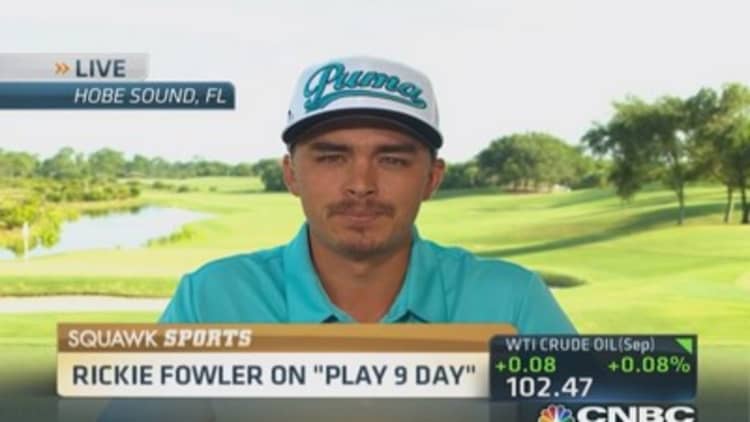The death of golf may be greatly exaggerated, as the saying goes, but there's little doubt the sport is on the decline.
Evidence includes a dwindling number of players in recent years, which contributed this week to the decision by Dick's Sporting Goods to fire the PGA professionals who consulted customers in its more than 560 stores.
Often cited for the game's drop-off are the costs of playing, the time it takes, the perception that it's a game for snobs and modern distractions such as sitting in front of a computer.
But if there's one major reason for shrinking interest by Americans in golf, it pretty much starts and ends with the success and ultimate hard times of one player.
Read MoreThe Queen's top racehorse fails drugs test
"Tiger Woods changed the game and interest in it," said Pat Rishe, professor of sports economics at Webster University. "We got spoiled by all he did when he was winning. He created a spike in golf that we're unlikely to see again."
That spike has gone away with Woods' personal problems in 2009 and recent physical ailments, said Rishe, and so has a lot of enthusiasm for the average person to pick up the game.
Rishe added that it will likely take another American golfer on a winning streak to bring the interest back.
"A Rickie Fowler or a Dustin Johnson could help," he argued. "But it will take someone with the 'It' factor, someone with the style and who's attractive to the average person."
But hold on, said PGA of America president Ted Bishop, who owns and operates The Legends Golf Club in Franklin, Indiana.
Bishop said the layoffs at Dick's Sporting Goods are more a reflection of a bad business model than a true picture of the sport.
"A lot of golf manufacturers flooded the market with products that didn't sell," he said. "I don't think you can link what happened with Dick's to golf itself."
In fact, the continuing bad press about golf's decline is not accurate, Bishop said, adding that "golf is not in a hole or in a rut."

According to the National Golf Foundation, there were 25.3 million golfers in the U.S. in 2012. However, that's down from 25.7 million in 2011 and 26.1 million in 2010.
The biggest drop-off in players is among the younger generation, with 200,000 players under the age of 35 leaving the game last year, according to the NGF.
However, PGA of America's Bishop said that what's not mentioned about the overall drop off is that nearly the same amount of players took up the game in 2013.
Another indicator used to show the decline in golf are the number of golf courses built. The NGF said that only 14 new courses (in 18-hole equivalents) were built in 2013 in the United States, and another 157.5 closed their doors, for a net loss of 143.5 courses.
Read MoreCEO: Coach Rivers threatens to quit Clippers
As for playing the game, that can take up to four hours or more for a round of 18 holes, and costs vary from course to course. But playing seven, 18-hole rounds at the average of $44 per round would cost $308.
That's not including the cost of clubs, which on average sell for around $40 each. Golfers also need to buy golf balls, golf shoes, gloves, hats.
But golf remains big business. According to a report by SRI International for trade organization Golf 20/20, the total size of the U.S. golf economy is more than $75 billion.
The National Sporting Goods Association said that in 2011, consumers spent $3.56 billion on golf equipment, while wholesale sales of golf equipment had a value of about $2.5 billion.
Some golf officials are aware of their sport's decline, and several ideas have circulated to change the game to bring in more players.
Country clubs are lowering prices for membership and non-member rounds of golf. There's talk of cutting playing 18 holes in tournaments to just nine.
A bit more on the wacky side is an idea to increase the golf hole from 4.25 inches in diameter to 15 inches, in order to make the game easier and faster.
Better still, another thought is to play FootGolf at courses, where people almost become football players (soccer to Americans) and kick the ball into the cup.
There is something called the American FootGolf League that started in 2011: The game is played with a regulation No. 5 soccer ball at a golf course facility on shortened holes with 21-inch diameter cups.
FootGolf has spread to the golf course of PGA America's Ted Bishop, where they've had, "more FootGolfers on our par 3 course than regular golfers."
Read MoreUS Soccer chief (an economist) wants big changes
"Price reductions will help, but these other ideas aren't really going to bring in more players," said Webster University's Rishe. "They're just too 'out there.'"
What will happen, said Rishe, is that golf will continue to decline in popularity. It won't go away, he said, but will likely tread water over the next couple of decades.
That is, unless Tiger Woods becomes Tiger again. Despite a bad showing at the recent British Open following back surgery, Woods did win five tournaments last year. Or, perhaps there's another "Tiger" ready to move up, argued Rishe.
"There are some American young guns out there," he said. "If they get rolling and winning, I think you'll see golf get more popular."
—By CNBC's Mark Koba


